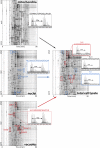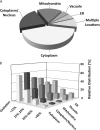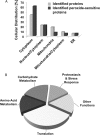Using quantitative redox proteomics to dissect the yeast redoxome
- PMID: 21976664
- PMCID: PMC3308895
- DOI: 10.1074/jbc.M111.296236
Using quantitative redox proteomics to dissect the yeast redoxome
Abstract
To understand and eventually predict the effects of changing redox conditions and oxidant levels on the physiology of an organism, it is essential to gain knowledge about its redoxome: the proteins whose activities are controlled by the oxidation status of their cysteine thiols. Here, we applied the quantitative redox proteomic method OxICAT to Saccharomyces cerevisiae and determined the in vivo thiol oxidation status of almost 300 different yeast proteins distributed among various cellular compartments. We found that a substantial number of cytosolic and mitochondrial proteins are partially oxidized during exponential growth. Our results suggest that prevailing redox conditions constantly control central cellular pathways by fine-tuning oxidation status and hence activity of these proteins. Treatment with sublethal H(2)O(2) concentrations caused a subset of 41 proteins to undergo substantial thiol modifications, thereby affecting a variety of different cellular pathways, many of which are directly or indirectly involved in increasing oxidative stress resistance. Classification of the identified protein thiols according to their steady-state oxidation levels and sensitivity to peroxide treatment revealed that redox sensitivity of protein thiols does not predict peroxide sensitivity. Our studies provide experimental evidence that the ability of protein thiols to react to changing peroxide levels is likely governed by both thermodynamic and kinetic parameters, making predicting thiol modifications challenging and de novo identification of peroxide sensitive protein thiols indispensable.
Figures




Similar articles
-
Modulation of the specific glutathionylation of mitochondrial proteins in the yeast Saccharomyces cerevisiae under basal and stress conditions.Biochem J. 2017 Mar 15;474(7):1175-1193. doi: 10.1042/BCJ20160927. Biochem J. 2017. PMID: 28167699
-
The Saccharomyces cerevisiae proteome of oxidized protein thiols: contrasted functions for the thioredoxin and glutathione pathways.J Biol Chem. 2006 Apr 14;281(15):10420-30. doi: 10.1074/jbc.M513346200. Epub 2006 Jan 17. J Biol Chem. 2006. PMID: 16418165
-
Quantifying changes in the bacterial thiol redox proteome during host-pathogen interaction.Redox Biol. 2019 Feb;21:101087. doi: 10.1016/j.redox.2018.101087. Epub 2018 Dec 19. Redox Biol. 2019. PMID: 30682706 Free PMC article.
-
Proteome screens for Cys residues oxidation: the redoxome.Methods Enzymol. 2010;473:199-216. doi: 10.1016/S0076-6879(10)73010-X. Methods Enzymol. 2010. PMID: 20513479 Review.
-
How to flip the (redox) switch.Cell. 2002 Nov 27;111(5):607-10. doi: 10.1016/s0092-8674(02)01165-0. Cell. 2002. PMID: 12464172 Review.
Cited by
-
The Cys Sense: Thiol Redox Switches Mediate Life Cycles of Cellular Proteins.Biomolecules. 2021 Mar 22;11(3):469. doi: 10.3390/biom11030469. Biomolecules. 2021. PMID: 33809923 Free PMC article. Review.
-
The Impact of Oxidative Stress on Ribosomes: From Injury to Regulation.Cells. 2019 Nov 2;8(11):1379. doi: 10.3390/cells8111379. Cells. 2019. PMID: 31684095 Free PMC article. Review.
-
Proteomic analysis of early-responsive redox-sensitive proteins in Arabidopsis.J Proteome Res. 2012 Jan 1;11(1):412-24. doi: 10.1021/pr200918f. Epub 2011 Nov 21. J Proteome Res. 2012. PMID: 22050424 Free PMC article.
-
Entamoeba histolytica-Gut Microbiota Interaction: More Than Meets the Eye.Microorganisms. 2021 Mar 12;9(3):581. doi: 10.3390/microorganisms9030581. Microorganisms. 2021. PMID: 33809056 Free PMC article. Review.
-
Mitoproteomics: Tackling Mitochondrial Dysfunction in Human Disease.Oxid Med Cell Longev. 2018 Nov 8;2018:1435934. doi: 10.1155/2018/1435934. eCollection 2018. Oxid Med Cell Longev. 2018. PMID: 30533169 Free PMC article. Review.
References
-
- Winterbourn C. C., Hampton M. B. (2008) Free Radic. Biol. Med. 45, 549–561 - PubMed
-
- D'Autréaux B., Toledano M. B. (2007) Nat. Rev. Mol. Cell Biol. 8, 813–824 - PubMed
-
- Stadtman E. R., Berlett B. S. (1998) Drug Metab. Rev. 30, 225–243 - PubMed
-
- Cook J. A., Gius D., Wink D. A., Krishna M. C., Russo A., Mitchell J. B. (2004) Semin. Radiat. Oncol. 14, 259–266 - PubMed
-
- Lowell B. B., Shulman G. I. (2005) Science 307, 384–387 - PubMed
Publication types
MeSH terms
Substances
Grants and funding
LinkOut - more resources
Full Text Sources
Other Literature Sources
Molecular Biology Databases

